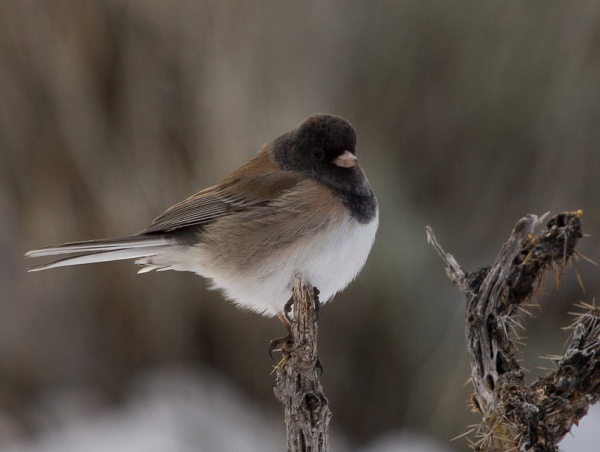
17 November 2015
The juncos are back in town and even if they don’t look exactly alike I can assure you they’re all dark-eyed juncos.
This wasn’t always the case. When I was young there were seven species of juncos: white-winged, Oregon, slate-colored, gray-headed, Guadalupe, Mexican and Baird’s. In Pittsburgh we normally saw slate-colored juncos and were very excited when an Oregon junco showed up.
Then in 1983 the American Ornithological Union (AOU) determined that despite plumage differences there are really only two species: dark-eyed junco (Junco hyemalis) and yellow-eyed junco (Junco phaeonotus). All the plumage colors are members of the 15 +/- subspecies.
Dark eyed juncos range from Alaska and Canada down to Mexico. Yellow-eyed juncos are found only in Mexico, southern Arizona and southern New Mexico.
Here’s a bird in New Mexico with dark eyes that used to be the “Oregon junco” species.

And here’s a yellow-eyed junco in Tucson.

So when you see an odd-looking junco don’t worry that his feathers don’t match the other birds. Check his eyes. Eye color is all that matters when parsing the two species of juncos.
UPDATE in 2022: However …! If you can identify junco subspecies it’s a thrill to find one out of its normal range or a hybrid such as the slate-colored/cismontanus junco that David Yeany found in February 2022. Here’s a February 2022 eBird checklist by Amy Henrici that includes photos of that bird.
(photos of dark-eyed juncos by Cris Hamilton and Steve Valasek. photo of yellow-eyed junco from Wikimedia Commons; click on the image to see the original)
I think I’ve asked this before, and if so, I’m going to ask this again: how does the AOU define species? if I remember correctly, in high school we learned that if two animals mate and produce non-fertile offspring, they are two different species. Did the AOU determine that dark-eyed juncos and yellow-eyed juncos, if they mated, would not produce fertile offspring?
The Oregon juncos are still always exciting to see in the northeast, regardless.
Steve, I don’t know the criteria but I know it involves more than just interbreeding (ex: Mallards hybridize & produce fertile offspring). I do know that the AOU is paying lots of attention to DNA.